
Second walls of Brussels
Encyclopedia

First walls


Belgium
Belgium , officially the Kingdom of Belgium, is a federal state in Western Europe. It is a founding member of the European Union and hosts the EU's headquarters, and those of several other major international organisations such as NATO.Belgium is also a member of, or affiliated to, many...
city of Brussels
Brussels
Brussels , officially the Brussels Region or Brussels-Capital Region , is the capital of Belgium and the de facto capital of the European Union...
in the early 13th century. The city quickly outgrew them, and starting in 1356, a second, larger set of walls was built to better enclose and defend the city. The now superfluous walls were dismantled between the 16th to 18th centuries. Isolated portions of the first walls can still be seen today.
Construction
Construction on the first walls of Brussels is estimated to have been at the beginning of the 13th century, under the reign of Henry IHenry I, Duke of Brabant
Henry I of Brabant , named "The Courageous" Duke of Brabant and Duke of Lower Lotharingia until his death.-Biography:...
, the first Duke of Brabant
Duke of Brabant
The Duchy of Brabant was formally erected in 1183/1184. The title "Duke of Brabant" was created by the German Emperor Frederick Barbarossa in favor of Henry I, son of Godfrey III of Leuven . The Duchy of Brabant was a feudal elevation of the since 1085/1086 existing title of Landgrave of Brabant...
. The beginning and end dates are not clear, but construction would have lasted several decades. On the other hand, from historical maps and other documents that have been preserved, the precise former course of the walls is known.
The walls were 4 kilometres (2.5 mi) long. In the west, they encompassed the site of the city's founding and first development, Saint-Géry Island, the Grand Place
Grand Place
The Grand Place or Grote Markt is the central square of Brussels. It is surrounded by guildhalls, the city's Town Hall, and the Breadhouse . The square is the most important tourist destination and most memorable landmark in Brussels, along with the Atomium and Manneken Pis...
and the first port on the Senne
Senné
Senné is a village and municipality in the Veľký Krtíš District of the Banská Bystrica Region of southern Slovakia.-External links:*http://www.statistics.sk/mosmis/eng/run.html...
river. It extended to the heights in the east of the city, enclosing the first St. Michael and St. Gudula Cathedral (then a collegiate church
Collegiate church
In Christianity, a collegiate church is a church where the daily office of worship is maintained by a college of canons; a non-monastic, or "secular" community of clergy, organised as a self-governing corporate body, which may be presided over by a dean or provost...
) on Treurenberg hill, the Sablon/Zavel area, and the ducal palace of Coudenberg
Coudenberg
Coudenberg or Koudenberg is a small hill in Brussels where the Palace of Coudenberg was built.For nearly 700 years, the Castle and then the Palace of Coudenberg were the seat of government of the counts, dukes, archdukes, kings, emperors and governors who from the 11th century until its...
.
The walls were initially made of earth, with a wooden fence on top. These gave way to walls made of stone that were 10 metres (32.8 ft) tall and 1 to 2.5 m (3.3 to 8.2 ft) thick. The walls were supported by square pillar
Column
A column or pillar in architecture and structural engineering is a vertical structural element that transmits, through compression, the weight of the structure above to other structural elements below. For the purpose of wind or earthquake engineering, columns may be designed to resist lateral forces...
s, spaced roughly 4 metres (13.1 ft) apart, linked by a row of arches for support. These were buried underneath a talus
Talus (fortification)
The talus is an architectural feature of some late medieval castles, especially prevalent in crusader constructions. It consists of a sloping face at the base of a fortified wall. The slope acts as an effective defensive measure in two ways. First, conventional siege equipment is less effective...
, and they supported the main wall, which had a number of arrow slits
Balistraria
An arrowslit is a thin vertical aperture in a fortification through which an archer can launch arrows....
in it. A second arcade
Arcade (architecture)
An arcade is a succession of arches, each counterthrusting the next, supported by columns or piers or a covered walk enclosed by a line of such arches on one or both sides. In warmer or wet climates, exterior arcades provide shelter for pedestrians....
supported a crenellated parapet
Parapet
A parapet is a wall-like barrier at the edge of a roof, terrace, balcony or other structure. Where extending above a roof, it may simply be the portion of an exterior wall that continues above the line of the roof surface, or may be a continuation of a vertical feature beneath the roof such as a...
, where defenders could stand. A large ditch was dug in front of the walls, and in places this could be flooded with water to form a moat
Moat
A moat is a deep, broad ditch, either dry or filled with water, that surrounds a castle, other building or town, historically to provide it with a preliminary line of defence. In some places moats evolved into more extensive water defences, including natural or artificial lakes, dams and sluices...
if needed. Along the length of the walls, there were roughly 40 defensive towers, in addition to seven primary gates and five smaller entrances.
Flemish invasion
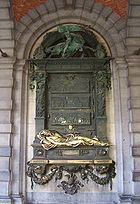
John III, Duke of Brabant
Jan III van Brabant , also called John III, the Triumphant , was Duke of Brabant, Lothier, and Limburg...
in 1355 sparked a succession crisis. As both of his sons had died, he left the throne to his daughter Joanna
Joanna, Duchess of Brabant
Joanna, Duchess of Brabant , also known as Jeanne, was the heiress of Duke John III, who died in Brussels, December 5, 1355. Her mother was Marie d'Évreux.- Family :...
and her husband Wenceslaus I of Luxembourg. Louis II
Louis II of Flanders
Louis II of Flanders , also Louis III of Artois and Louis I of Palatine Burgundy, known as Louis of Male, was the son of Louis I of Flanders and Margaret I of Burgundy, and Count of Flanders.On his father's death at the Battle of Crécy in 1346, he inherited the counties of Flanders, Nevers, and...
, Count of Flanders
Count of Flanders
The Count of Flanders was the ruler or sub-ruler of the county of Flanders from the 9th century until the abolition of the position by the French revolutionaries in 1790....
had married Joan's younger sister Margaret
Margaret of Brabant
Margaret of Brabant , was the daughter of John I, Duke of Brabant and Margaret of Flanders. She was the wife of Count Henry of Luxemburg and after his coronation in 1308, she became Queen of Germany.-Family:...
and thought the throne should be his. Louis invaded Brabant and quickly seized Brussels, planting the Flemish lion flag
Flag of Flanders
The flag of Flanders, called the Vlaamse Leeuw or leeuwenvlag , is the flag of the Flemish Community and Flemish Region. The flag was officially adopted by the Raad voor de Nederlandse Cultuurgemeenschap in 1973, and later, in 1985, by its successor, the Flemish Parliament...
in the middle of the Grand Place
Grand Place
The Grand Place or Grote Markt is the central square of Brussels. It is surrounded by guildhalls, the city's Town Hall, and the Breadhouse . The square is the most important tourist destination and most memorable landmark in Brussels, along with the Atomium and Manneken Pis...
. The city walls offered relatively little protection.
During the night of 24 October 1356, a group of Brabantian patriots led by Everard 't Serclaes
Everard 't Serclaes
Everard 't Serclaes , lord of Cruyckembourg , a citizen of Brussels, was made famous by his recovery of that city from the Flemish....
scaled the city walls and drove the Flemings from the city. This enabled Joanna and Wenceslaus to make their Joyous Entry
Joyous Entry of 1356
The Joyous Entry of 1356 into Brussels is the charter of liberties granted to the Duchy of Brabant following the death in 1355 of Duke John III, by his daughter Joanna, the new Duchess, and her husband Wenceslaus, Duke of Luxembourg...
into Brussels, which would be seen as the equivalent of the Magna Carta
Magna Carta
Magna Carta is an English charter, originally issued in the year 1215 and reissued later in the 13th century in modified versions, which included the most direct challenges to the monarch's authority to date. The charter first passed into law in 1225...
for the Low Countries
Low Countries
The Low Countries are the historical lands around the low-lying delta of the Rhine, Scheldt, and Meuse rivers, including the modern countries of Belgium, the Netherlands, Luxembourg and parts of northern France and western Germany....
.
New walls proposed
Since the construction of the first walls in the 13th century, Brussels had grown extensively and had become quite important. On account of this growth, the first walls were no longer large enough, as the city had begun to spread out beyond them. It had become clear that further defences, better adapted to the current era, needed to be adopted. Following the succession crisis, city authorities decided to build a new set of walls. Everard 't SerclaesEverard 't Serclaes
Everard 't Serclaes , lord of Cruyckembourg , a citizen of Brussels, was made famous by his recovery of that city from the Flemish....
, who had been named schepen
Schepen
A schepen is a Dutch word referring to a municipal civic office in Dutch-speaking countries. The term is still in use in Belgium, but it has been replaced by wethouder in the Netherlands. The closest English terms are alderman, member of the municipal executive, councillor and magistrate,...
, was among those contributing to the decision.
Second walls
.jpg)
Hamlet (place)
A hamlet is usually a rural settlement which is too small to be considered a village, though sometimes the word is used for a different sort of community. Historically, when a hamlet became large enough to justify building a church, it was then classified as a village...
and fields that supplied the city. There were to be 72 semicircular towers along the wall. There were seven main gates, corresponding to the seven entries into the first walls of Brussels, but the similarities mostly end there. The second walls were a monumental project and represented a colossal undertaking for the period. The design was fairly typical of medieval defences before the introduction of gunpowder, and was surrounded by a moat
Moat
A moat is a deep, broad ditch, either dry or filled with water, that surrounds a castle, other building or town, historically to provide it with a preliminary line of defence. In some places moats evolved into more extensive water defences, including natural or artificial lakes, dams and sluices...
in the lower parts of the city. The two sets of walls coexisted until the 16th century, when the original set of walls began to be dismantled.
Evolution of defences
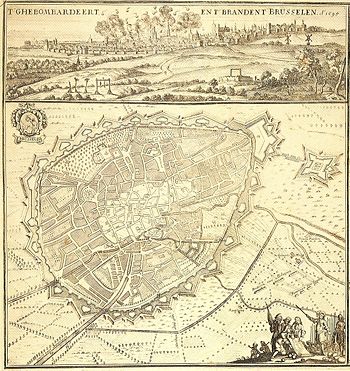
County of Flanders
The County of Flanders was one of the territories constituting the Low Countries. The county existed from 862 to 1795. It was one of the original secular fiefs of France and for centuries was one of the most affluent regions in Europe....
, Anderlecht
Anderlecht
Anderlecht is one of the nineteen municipalities located in the Brussels-Capital Region.There are several historically and architecturally distinct districts within the Anderlecht municipality.-Pronunciation:* Dutch: * French:...
, Halle
Halle, Belgium
Halle , is a Belgian city and municipality in the district Halle-Vilvoorde of the province Flemish Brabant. The city is located on the Brussels-Charleroi Canal and on the Flemish side of the language border that separates Flanders and Wallonia...
, Namur
Namur (city)
Namur is a city and municipality in Wallonia, in southern Belgium. It is both the capital of the province of Namur and of Wallonia....
, Leuven
Leuven
Leuven is the capital of the province of Flemish Brabant in the Flemish Region, Belgium...
and Schaerbeek, each named for the direction of the road leading out of the gate. An eighth was added in 1561, the Canal Gate, designed to control access to Brussels' port from the newly constructed Willebroek Canal.
In the 16th and 17th centuries, new siege weapons and techniques, including the advent of artillery
Artillery
Originally applied to any group of infantry primarily armed with projectile weapons, artillery has over time become limited in meaning to refer only to those engines of war that operate by projection of munitions far beyond the range of effect of personal weapons...
, forced the city to modernize the defences in order to keep potential attackers at a safe distance from the walls, including the addition of ditches, bastion
Bastion
A bastion, or a bulwark, is a structure projecting outward from the main enclosure of a fortification, situated in both corners of a straight wall , facilitating active defence against assaulting troops...
s and ravelin
Ravelin
A ravelin is a triangular fortification or detached outwork, located in front of the innerworks of a fortress...
s. Monterey Fort was the most important defensive work, its name coming from the Spanish
Spain
Spain , officially the Kingdom of Spain languages]] under the European Charter for Regional or Minority Languages. In each of these, Spain's official name is as follows:;;;;;;), is a country and member state of the European Union located in southwestern Europe on the Iberian Peninsula...
count responsible for modernizing the defences. The fort was built between 1672 and 1675 on the heights of Obbrussel (Upper Brussels, now Saint-Gilles
Saint-Gilles
Saint-Gilles is the name of several places, most of them named after Saint Giles.-Belgium:* Saint-Gilles is the French name for a municipality in the bilingual Brussels-Capital Region...
), south of the Halle Gate
Halle Gate
The Porte de Hal or Hallepoort is a medieval fortified city gate of the second walls of Brussels.Built in 1381, Halle Gate is a 14th century city gate from the second set of defensive walls that enclosed Brussels. The gate was named for the city of Halle in Flemish Brabant which it faces.The...
, by the military engineer
Military engineer
In military science, engineering refers to the practice of designing, building, maintaining and dismantling military works, including offensive, defensive and logistical structures, to shape the physical operating environment in war...
s Merex and Blom. As with the rest of the city's fortifications, the fort was ineffective, and was not able to prevent the French bombardment of Brussels
Bombardment of Brussels
The bombardment of Brussels by French troops of King Louis XIV on August 13, 14 and 15, 1695 and the resulting fire were together the most destructive event in the entire history of Brussels. The Grand Place was destroyed, along with a third of the buildings in the city...
in 1695, from the heights of Scheut, in Anderlecht
Anderlecht
Anderlecht is one of the nineteen municipalities located in the Brussels-Capital Region.There are several historically and architecturally distinct districts within the Anderlecht municipality.-Pronunciation:* Dutch: * French:...
, as part of the War of the Grand Alliance
War of the Grand Alliance
The Nine Years' War – often called the War of the Grand Alliance, the War of the Palatine Succession, or the War of the League of Augsburg – was a major war of the late 17th century fought between King Louis XIV of France, and a European-wide coalition, the Grand Alliance, led by the Anglo-Dutch...
. The defensive works proved equally ineffective when French troops seized the city
Siege of Brussels
The Siege of Brussels took place between January and February 1746 during the War of the Austrian Succession. A French army under the overall command of Maurice de Saxe besieged and captured the city of Brussels, which was then the capital of the Austrian Netherlands, from its Austrian garrison.The...
in 1746 during the War of the Austrian Succession
War of the Austrian Succession
The War of the Austrian Succession – including King George's War in North America, the Anglo-Spanish War of Jenkins' Ear, and two of the three Silesian wars – involved most of the powers of Europe over the question of Maria Theresa's succession to the realms of the House of Habsburg.The...
, afterwards leaving the defensive works in ruins. By that time, siege was no longer an important part of warfare. Due to the growth of commerce and improved roads, the fortifications did little more than frustrate transit into and out of the city.
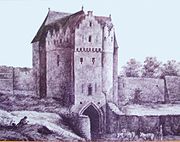
Joseph II, Holy Roman Emperor
Joseph II was Holy Roman Emperor from 1765 to 1790 and ruler of the Habsburg lands from 1780 to 1790. He was the eldest son of Empress Maria Theresa and her husband, Francis I...
ordered the dismantling of most fortifications in the Low Countries
Low Countries
The Low Countries are the historical lands around the low-lying delta of the Rhine, Scheldt, and Meuse rivers, including the modern countries of Belgium, the Netherlands, Luxembourg and parts of northern France and western Germany....
, including those of Brussels. The dismantling work of the exterior defences began in the east of the city. Monterey Fort was sold and destroyed, and all of the Gates were raze
Raze
Raze may refer to:* Demolition* Raze, Haute-Saône, a town in France* Raze * Raze * Raze , a fictional character in the Underworld films* Raze , a made for TV film aired on syfy...
d with the exception of Laeken Gate and Halle Gate
Halle Gate
The Porte de Hal or Hallepoort is a medieval fortified city gate of the second walls of Brussels.Built in 1381, Halle Gate is a 14th century city gate from the second set of defensive walls that enclosed Brussels. The gate was named for the city of Halle in Flemish Brabant which it faces.The...
.
In 1795, when Republican France invaded and annex
Annexation
Annexation is the de jure incorporation of some territory into another geo-political entity . Usually, it is implied that the territory and population being annexed is the smaller, more peripheral, and weaker of the two merging entities, barring physical size...
ed the Low Countries
Low Countries
The Low Countries are the historical lands around the low-lying delta of the Rhine, Scheldt, and Meuse rivers, including the modern countries of Belgium, the Netherlands, Luxembourg and parts of northern France and western Germany....
, the demolitions were stopped, not resuming until an order from Napoleon in 1804. Laeken Gate was destroyed in 1808. By an ordinance
Ordonnance (French constitutional law)
In the Government of France, an ordonnance is a statute passed by the Council of Ministers in an area of law normally reserved for statute law passed by the Parliament of France....
on May 19, 1810, the French Emperor ordered the second walls demolished and replaced by boulevards with a median
Median
In probability theory and statistics, a median is described as the numerical value separating the higher half of a sample, a population, or a probability distribution, from the lower half. The median of a finite list of numbers can be found by arranging all the observations from lowest value to...
in the centre. The fall of the First French Empire
First French Empire
The First French Empire , also known as the Greater French Empire or Napoleonic Empire, was the empire of Napoleon I of France...
prevented the project's immediate execution.
Construction of the small ring
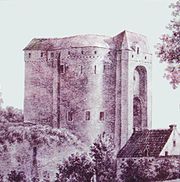
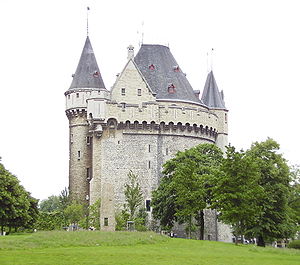
In 1830, as Belgium gained its independence
Belgian Revolution
The Belgian Revolution was the conflict which led to the secession of the Southern provinces from the United Kingdom of the Netherlands and established an independent Kingdom of Belgium....
, demolition work had reached Halle Gate
Halle Gate
The Porte de Hal or Hallepoort is a medieval fortified city gate of the second walls of Brussels.Built in 1381, Halle Gate is a 14th century city gate from the second set of defensive walls that enclosed Brussels. The gate was named for the city of Halle in Flemish Brabant which it faces.The...
. Since its closing, it had served as a military prison, and later as storage of archives. The new government decided to spare it. In 1840, the street just inside of the gate was raised 3 metres, making it impassable to vehicles. From 1868 to 1871, as the city was being modernized, architect Hendrik Beyaert
Hendrik Beyaert
Hendrik Beyaert or Henri Beyaert was a Belgian architect.He was born in Kortrijk, Belgium on 29 July 1823 and died in Brussels 22 January 1894. He is considered one of the most important Belgian architects of the 19th-century....
, with little regard for historical accuracy, transformed the austere medieval tower into something of a neo-Gothic castle, which fit better with the contemporary romantic
Romanticism
Romanticism was an artistic, literary and intellectual movement that originated in the second half of the 18th century in Europe, and gained strength in reaction to the Industrial Revolution...
perception of the middle ages
Middle Ages
The Middle Ages is a periodization of European history from the 5th century to the 15th century. The Middle Ages follows the fall of the Western Roman Empire in 476 and precedes the Early Modern Era. It is the middle period of a three-period division of Western history: Classic, Medieval and Modern...
.
In 1860, the taxes on commercial goods were lifted, and the last barrier between Brussels and its suburbs was destroyed. The intersections at Anderlecht Gate and Ninove Gate are the only two where the customs houses still stand. Those of Namur Gate were moved, and now stand at the end of Avenue Louise
Avenue Louise
Avenue Louise or Louizalaan is a major thoroughfare in Brussels. It runs southeast from Louise Square to the Bois de la Cambre, covering a distance of .- History :...
, at the entrance to the Bois de la Cambre
Bois de la Cambre
Ter Kamerenbos or Bois de la Cambre is an urban public park on the edge of the Sonian Forest in Brussels, Belgium. It has an area of 1.23 square kilometres. The park lies in the south of the Brussels-Capital Region, and in the municipality of the City of Brussels...
.
Although modified, Halle Gate
Halle Gate
The Porte de Hal or Hallepoort is a medieval fortified city gate of the second walls of Brussels.Built in 1381, Halle Gate is a 14th century city gate from the second set of defensive walls that enclosed Brussels. The gate was named for the city of Halle in Flemish Brabant which it faces.The...
is the last remnant of the second walls of Brussels. Their course can be seen by the current Small Ring
Small ring (Brussels)
The Brussels small ring or inner ring road is a series of roadways in central Brussels, Belgium, surrounding the historic city centre. It was built on the site of the Second walls of Brussels, built in the 16th century, after they were torn down....
, although it stops short of Halle Gate, and they still define the downtown of Brussels, often called the pentagon. In the 1950s, with pressure from the automobile
Automobile
An automobile, autocar, motor car or car is a wheeled motor vehicle used for transporting passengers, which also carries its own engine or motor...
, new plans to improve traffic flow were implemented, partly due to the 1958 World's Fair
Expo '58
Expo 58, also known as the Brussels World’s Fair, Brusselse Wereldtentoonstelling or Exposition Universelle et Internationale de Bruxelles, was held from 17 April to 19 October 1958...
. Later tunnels were dug, and one of the main lines of the Brussels Metro
Brussels Metro
The Brussels Metro is a rapid transit system serving a large part of the Brussels-Capital Region of Belgium. It consists of a network with four metro line services with some shared sections. The metro has 49.9 km of network and 59 stations...
now runs primarily underneath the small ring. Today, the small ring is a major arterial ring road
Ring road
A ring road, orbital motorway, beltway, circumferential highway, or loop highway is a road that encircles a town or city...
.
Further reading/guidebooks
La Première Enceinte de Bruxelles, Corinne Licoppe (ed.), no. 29 in the series Bruxelles, Ville d'Art et d'Histoire, Ministère de la Région de Bruxelles-Capitale, Service des Monuments et Sites, 2001La Porte de Hal - Temoin silencieux d'une histoire tumultueuse, Linda Wullus, Musées Royaux d'Art et d'Histoire, 2006

